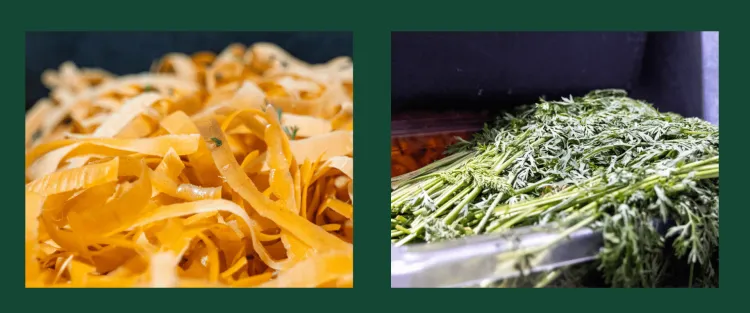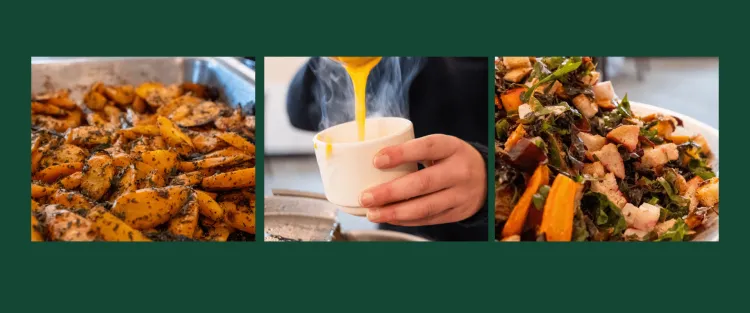A carrot spends about sixty days growing in the soil before it’s harvested, transported, and prepped, only for its peels and tops to be tossed aside. What if those ‘scraps’ could become part of the menu? Last week, UVM Dining and the UVM Climate Kitchen partnered to bring a pop-up to the Waterman Manor featuring a menu that designed waste out of the picture. This wasn’t just a lunch, but a demonstration of circular gastronomy in action.
Food Systems Research Institute PhD Fellow Sarra Talib has been researching circularity as a framework for sustainable food systems, with a focus on the role of chefs in the transition to a circular economy for food – that is, a food system where food is produced regeneratively, food products and materials are circulated (kept in use) at their best and highest value, and waste is eliminated by design. As part of her research, she developed a circular menu design scale to identify what circular practices were considered important by Vermont chefs. Circular economy principles also informed the UVM Climate Kitchen tenets for sustainable practices: plant forward, integrating tastes and habits, low waste, whole food utilization, and regional/local sourcing.
Together with UVM Dining’s Chef Dan Miele, Talib designed a buffet menu that minimized waste at every stage, from sourcing to serving, which they demonstrated over a two-day lunch event. The menu focused on using up all parts of the ingredients, repurposing byproducts (upcycling), sourcing from local vendors, and considering how to make the meal affordable.
“It was really exciting for me because this is actually kind of like how I cook at home,” said Miele. “I'm a big gardener and forager, so I try to tie the things in that I know we have up here. Carrots are in abundance right now. We’re trying to utilize all parts of the plant to showcase how many different things get thrown out that can be delicious things for people.”

Consider the carrot. This menu featured:
- Grilled carrots with a carrot-top pesto
- Potage crecy (French carrot soup) that utilized the carrot peels
- Root vegetable panzanella with roasted carrot and upcycled bread

And that’s just one example. Swiss chard greens were used in the panzanella salad and the stalks used to make a salsa verde topping for sumac-infused tofu. “That's also a way to minimize waste because you're using a single ingredient across different menu items,” said Talib. When cooking the chicken, the only animal protein on the menu, the chicken fat was rendered, and the liquid fat (schmaltz) was used in the potato pave giving it a delicious unctuous flavor and eliminating the need for another source of fat by repurposing a byproduct that is often discarded.
Local sourcing can be a challenge but can still be done creatively. “I think my stance on food is our food system's broken, unfortunately,” said Miele. “And my personal belief on it is that we just need to bring everything back to much more of a micro food environment. As much as I love having avocados in my fridge 365 days out of the year, we shouldn't probably be eating avocados in this state.” Miele believes local sourcing is important it supports local people and keeps money in the local economy. Plus, it has a lower impact on the environment since ingredients don’t need to be shipped across the country or globe. Ingredients for the lunch came from the Intervale, Vermont Soy, Champlain Orchards, and other local and regional producers.
The team prioritized financial sustainability and chose a buffet as the most effective way to minimize both waste and cost. Designing the main dishes to be plant-forward while incorporating meat into the sides proved not only environmentally responsible but also budget-friendly. By framing the experience as an “all you care to eat” buffet rather than the typical “all you can eat” and presenting the food in a minimalist style, diners were encouraged to take only what they truly wanted, with the reassurance that they could return for seconds.
This lunch was the second collaboration between the Climate Kitchen and UVM Dining. Talib was pleased with the event and says it is a great example of “how research and practice come together in a very powerful way.” On Friday November 14th, she will host a panel of local chefs to discuss circular gastronomy – how they are eliminating waste in their kitchens by design – as part of the UVM Food Systems Research Institute’s Food and Ideas Gathering.
This year UVM Dining was recognized for the Gold Award for Sustainable Procurement from the National Association of College and University Food Services (NACUFS) as part of the 2025 Sustainability Awards. Nicole Reilly, Sustainability and Campus Partnership Manager at UVM Dining, says that reducing waste is important throughout campus. “Whether that's through donations to Rally Cats Cupboard or feeding Champlain Valley or getting creative with the menu design, like we're all in,” she said.


